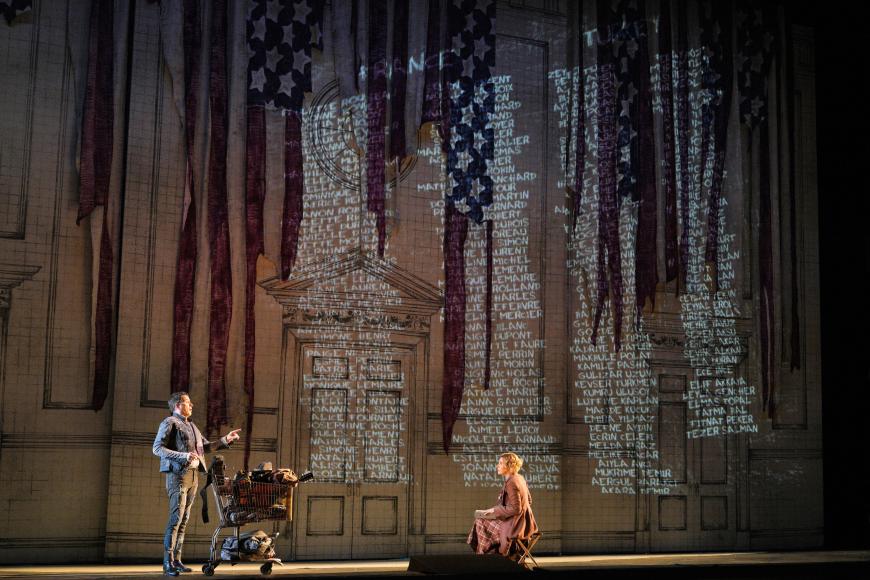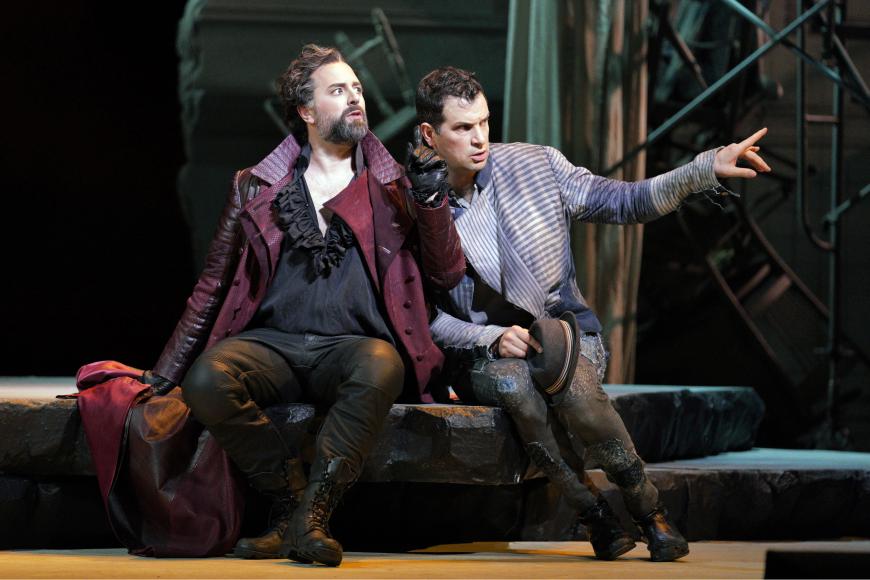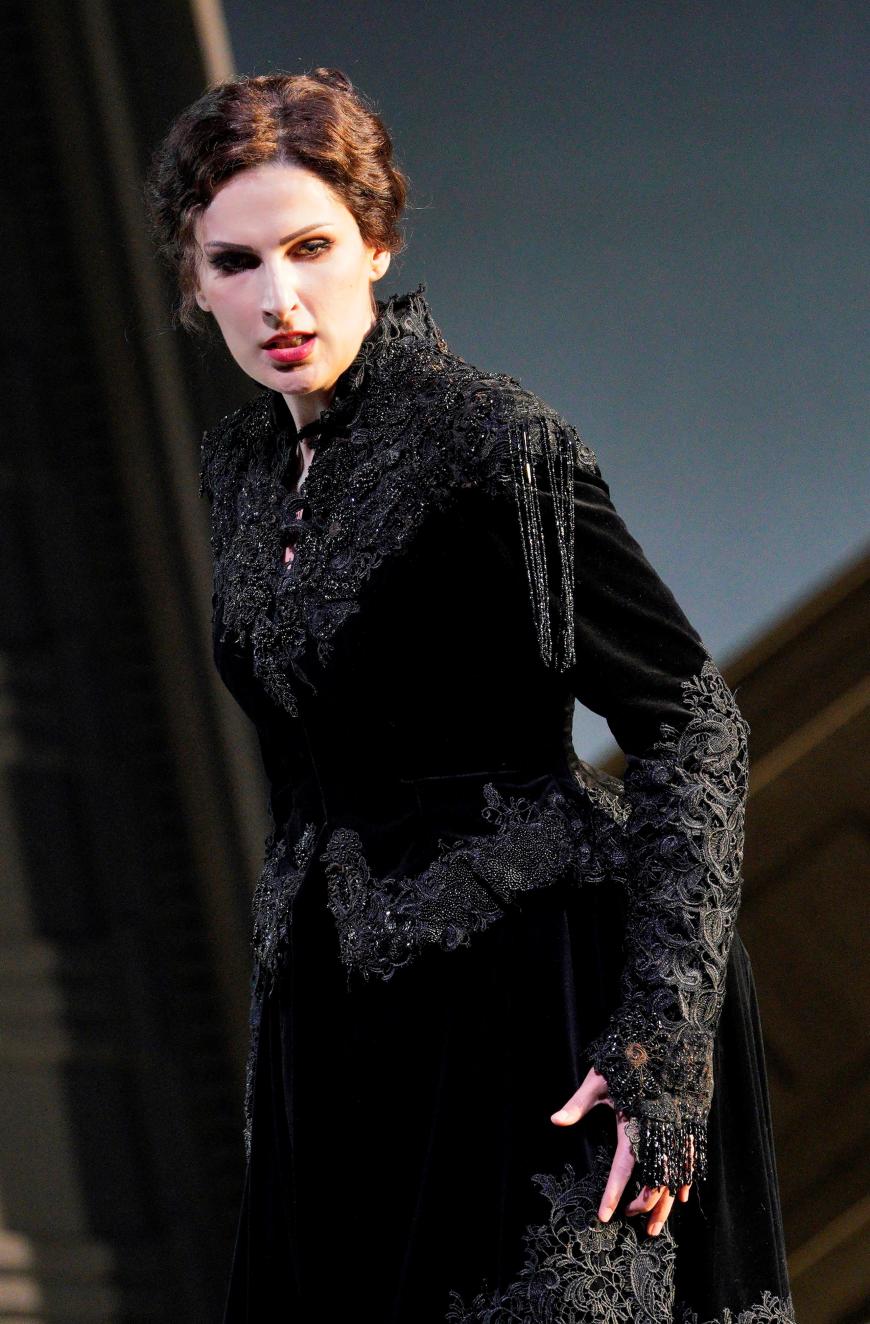
As the orchestra plays the overture in San Francisco Opera’s new production of Don Giovanni, images of environmental devastation and bombed-out neighborhoods are projected on the façade of the American manor house that has been the central symbol in the company’s staging of all three of the Mozart/DaPonte operas. The house’s American flag bunting now hangs in tatters. The setting is a post-apocalyptic world, circa 2080, made from our own short-sightedness, insolence, and cupidity. In that, we’re like the Don himself, it seems.
And while this is a familiar liberal diagnosis of the ills facing America post-lockdown, and in the midst of a worsening climate crisis, it serves the opera of Don Giovanni badly. Michael Cavanagh’s production, which opened Saturday, June 4, is strongest in its details and is ultimately saved by outstanding individual performances, but the conceptual overlay is weak tea.
Don Giovanni the character relies on a strong class system, in which the nobility are believed to be special, by virtue of their elevated social position. That’s how the Don hides his crimes. In America, Larry Nassar, Harvey Weinstein, Roger Ailes, and the like operated in a similar way. In this production, we look out on a world that is significantly impoverished, causing the chorus to dress like refugees from The Threepenny Opera while despoiling the dead body of the Commendatore. Leporello pushes a shopping cart filled with his worldly belongings, apparently homeless. The Commendatore and Giovanni face off with a baseball bat and a loose piece of scaffolding. It all seems less Mad Max and more like the right wing’s nightmare vision of American inner cities.

In that situation, would class and social position work in the same way? Would Giovanni offer “Zerlina is in the hands of a cavalier” as pledge of her personal safety (and expect to be believed)? In the libretto, Giovanni’s seduction style is almost wholly dependent on refined manners and the impression they make. He sings serenades and hands out suave compliments.
For this Giovanni, as played by Etienne Dupuis, manners are just a tactic, and brute force and threats are preferred and advertised. And he certainly does not fear discovery: In the Act 1 finale, he roars and stomps at his accusers, and they step back in alarm while he laughs insultingly. Dupuis still sings “Là ci darem la mano” wonderfully. What’s the point, though? This kind of seduction only works if social convention makes manners and smooth talking a marker of status.
Unifying concept aside, this is a regular, not revolutionary production that gets most of its juice from performances by the principals. Dupuis has a powerful, well-modulated voice and is a convincing actor who makes interesting dramatic choices. His partner in crime, Luca Pisaroni, as Leporello, goes one better; he never does anything remotely contrived in his performance — he just disappears into the character. And he’s at his peak as a singer, with tonal beauty throughout his range.

In Don Giovanni, however, it’s the women who take the spotlight most of the time, as Kristi Brown-Montesano points out in her program essay (and in her book, Understanding the Women of Mozart’s Operas): “The women’s joint resistance to Don Giovanni drives the narrative of the opera … thwarting the aims of his libidinous entitlement.” As she points out, Donna Anna is the musical center of the opera, leading the ensembles and singing three of its arias. There have been more powerful singers than Adela Zaharia cast in that role, but she is a perfect Mozartian soprano — clean attacks, on pitch, elegant yet fervently emotional. Her voice is flexible, clear, and enviable in every respect. She’s a good ensemble actor, too.
Nicole Car as Elvira is nimble on her feet and in stage business, which is perfect for a character who makes it her personal mission to foil the Don’s seduction attempts. Throughout the show, she displayed a tonal luster that in itself made you sit up and take notice.
Christina Gansch went full throttle as Zerlina. I really liked the absence of coquetry in her performance and the straightforward, unpretentious delivery of two of the operas most beloved arias.
In the supporting roles, Amitai Pati sang a lovely though somewhat stilted “Dalla sua pace.” He is an extremely capable singer with a less arresting voice than his colleagues. Cody Quattlebaum sang well, though he was a little underpowered, as Masetto. And Soloman Howard was all you could wish for, vocally and in personal presence, as the Commendatore.
Bertrand de Billy conducted the Vienna version of the score at a rapid clip, without losing many details. If he had cut the Zerlina-Leporello duet, he would have saved a good bit of time in a second act that really needs to get to the finale without too many episodes.
Editor’s note (June 10): San Francisco Opera’s planned livestream of the June 12 performance of Don Giovanni will not be broadcast “due to COVID-related staff shortages in support departments,” the company says. The Sunday matinee will still go on live and in person, and future streams this season remain on the schedule.




